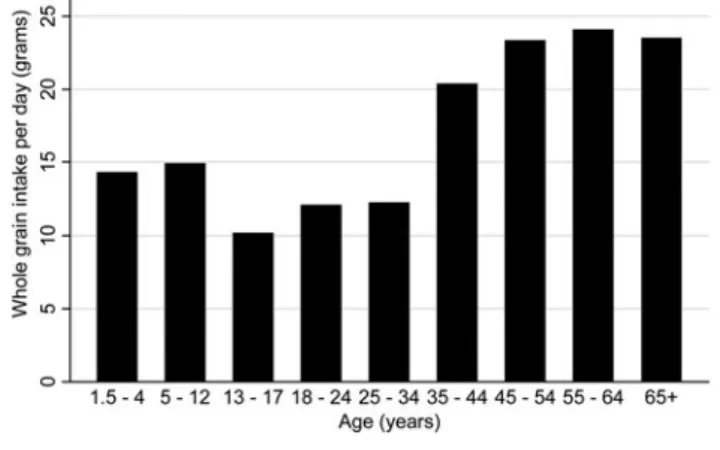Pr
oceedings
of
the
Nutrition
Society
Summer Meeting, 14–17 July 2014, Carbohydrates in health: friends or foes
Whole grain intake in the UK remains low: results from the National Diet
and Nutrition Survey rolling programme years 1, 2 and 3
K. D. Mann
1,2, M. S. Pearce
2, B. McKevith
3, F. Thielecke
4and C. J. Seal
11
Institute of Health & Society, Newcastle University, Newcastle upon Tyne, NE1 4LP, UK,
2Human Nutrition
Research Centre, Newcastle University, Newcastle upon Tyne NE1 7RU, UK,
3Cereal Partners UK, Welwyn Garden
City, AL7 1RR, UK and
4Cereal Partners Worldwide, Lausanne, Switzerland
Increased whole grain intake has been shown to reduce the risk of many non-communicable diseases such as cardiovascular disease, type 2 diabetes, obesity(1,2)and some cancers(3,4). In response to the evidence, some countries including the US, Canada, Denmark and Australia have dietary guidelines on whole grain intake. However, there is no whole grain specific dietary recommendation in the UK and analysis of dietary survey data from 1986 and 2000 showed that whole grain intake was low and declining in British adults(5). The aim of this study was to describe the whole grain intake in the most current dietary assessment of the UK, The National Diet and Nutrition Survey (NDNS) 2008-11.
The NDNS is a representative dietary survey of households in the UK. Four-day diet diaries were completed by 3073 individuals between 2008 and 2011, along with details of socio-economic status (SES). Daily whole grain intake was calculated for each individual on a dry weight basis. Median whole grain intake was 19·6 g/d and 13·4 g/d for adults (18+ years) and children/teenagers (1·5–17 years), respectively (Fig. 1). Whole grain intake increased with age but was lowest in teenagers (13–17 years) and younger adults up to age 34 years, for whom intakes were lower than those in all other age groups. There were 18% and 15% non-consumers of any wholegrain foods, for adults and children/teenagers, respectively. After adjustment for energy intake, adult females had higher whole grain intake than males. Those from lower SES groups had significantly lower whole grain intake than those more advantaged classifications.
Whole grain intake in this representative UK population was low. Intake was slightly higher than reported in the 2000/01 NDNS (14 g/d for adults over 19·6 g/d(5)). Teenagers and younger adults may need targeting to help increase whole grain consumption. Reducing the cost and increasing the availability of wholegrain foods may help to increase whole grain intake in the UK and other countries without whole grain dietary recommendations. Further investigation into the associated health benefits with whole grain intake in this population is needed.
1. Cho SS, Qi L, Fahey GC Jr. et al. (2013) Am J Clin Nutr 98, 594–619. 2. Ye EQ, Chacko SA, Chou EL et al. (2012) J Nutr 142, 1304–13. 3. Aune D, Chan DS, Lau R et al. (2011) BMJ 343:d6617.
4. Kyrø C, Skeie G, Loft S et al. (2013) Cancer Causes Control 24, 1363–1374. 5. Thane CW, Jones AR, Stephen AM et al. (2007) Br J Nutr 97, 987–992.
Fig. 1. Median whole grain intake by age
Proceedings of the Nutrition Society (2015), 74 (OCE1), E60 doi:10.1017/S0029665115000750
https:/www.cambridge.org/core/terms. https://doi.org/10.1017/S0029665115000750
